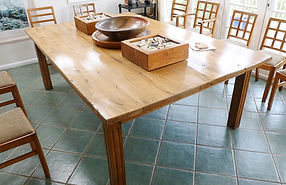Cornwall Furniture Restoration
Furniture restoration and repair
French polishing antique and modern
Tel. 07774687537 Email iantiques@btinternet.com
9A4 Restormel Industrial Estate Lostwithiel Cornwall PL22 0HG

menu
Furniture repairs
Repairs to a mahogany secretaire bookcase
This nineteenth century mahogany secretaire bookcase had to have many small repairs carried out including replacement beading to the drawers, gluing and restoring the original bracket feet. There was some damage to the quadrant stays which had to be repositioned. This piece was also cleaned and repolished prior to waxing


Repairing and polishing a pair of Edwardian chairs
This unusual pair of early 20th century chairs have been a little overused and as a consequence the joints have suffered. Also some of the ivorine was missing as well as small areas of marquetry starting to lift. The polished surface has also got signs of wear as well as the usual white paint spots. The seagrass seating was in pretty good condition and did not need further work. Thankfully there are no visible signs of worm.
These floral marquetry panels are unusual to be found on the back of a chair but are totally in keeping with the period the chair was made. Some of the pieces had to be glued back down and the panels were cleaned before french polishing and waxing.


The first thing to be done with these chairs was to check each of the joints for movement. All loose joints were knocked apart and cleaned down to remove the old glue. The frames were then reglued and cramped, making sure to keep the rails square . Next thing to do was to clean out the inlaid lines where the ivorine was missing and replace the missing pieces. The chairs were then lightly cleaned using a mixture of solvents. This brought out the natural beauty of the timbers and marquetry panels. After rubbing down with fine wire wool the chairs were then french polished and finally waxed.
Repairing antique furniture, an early 19th century dining table
I have recently been commissioned to carry out furniture repairs to a rather sad and old dining table. To say the antique table needs a little TLC would be an understatement, but in its hay day this early nineteenth century rosewood and brass inlaid table would have graced any dining room, and being large enough to seat six people would be able to tell a few stories, if indeed it was able to speak, which it is not. Antique furniture restoration was never the less necessary , just being short of two hundred years old, it has survived many a trauma and spillage, enough said ! The table has a striking rosewood veneered top which has two rings of brass stringing around the outer edge. The ornately antique carved base is also veneered over mahogany and has a brass catch which allows the top to be tilted to an upright position. The image on the right shows the sad looking fellow awaiting his forthcoming operation. Over the next couple of weeks I hope to be able to show you the gradual antique furniture restoration of this piece of . Let the repairs commence.
Nearly 200 years of use had taken its toll on this table and many of the joints had dried out, and so it was necessary for the antique furniture restorer to clean and reglue much of the rail under the top as well as the bad crack on the top. Once this had been accomplished ,all the missing turned bobbled molding was replaced and glued back in position. Any pieces of missing veneer were replaced and the channels for the brass inlay were rescratched so as to take the missing brass. Rosewood has a habit of turning black once the surface has been broken.



The image to the left shows the table top after the crack repairs had been carried out. This involved taking the top off , cleaning the joint and fixing back to the rosewood veneered framework. The turned moldings were then glued back around the edge and any missing veneer was then replaced. The whole antique top was then checked over for splits and cracks and was then cleaned back prior to polishing.. Work was then commenced on the base of the table which involved similar work.
The base of the table had missing carving and strips of veneer. Once this had been replaced and all furniture repairs were carried out ,then the table was french polished after having been grainfilled and any repairs were coloured in.

After carrying out furniture repairs to the top of the table, which included repairing splits, and re inlaying with brass strip, the top was then cleaned right back. Any bad stains were then teased out prior to grain filling. The whole top was then french polished and then dulled down with steel wool prior to waxing.
In my opinion rosewood furniture of the early eighteen hundreds has produced some of the best of its kind as regards quality and design.

